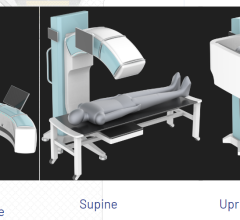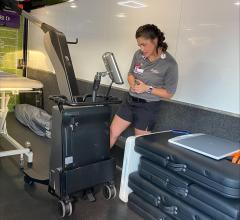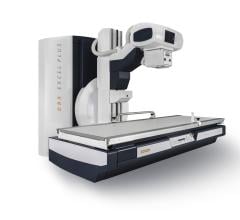
Carestream has built on its wireless detetor success with the DRX-Evolution, and providers are taking advantage of moving detectors between different rooms or of mobile X-ray systems.
With all of the major X-ray vendors now offering wireless digital radiography (DR) systems, prices have dropped and it is becoming an industry standard for digital X-ray room replacements, primarily for computed radiography (CR) systems.
A new report from KLAS, “Digital X-Ray Performance 2013: Impact of a Wireless Workflow,” released in June, shows providers are seeing big benefits from wireless detector technology. Report author Brady Heiner, director of research at KLAS, said providers report increased efficiency in patient throughput due in part to the reliability and excellent image quality of the wireless solutions. The performance report looks across the spectrum of deliverables that make up a good wireless system and finds Carestream leading the way overall, with GE pulling up the rear in a four-point spread. Providers cited reliability issues and some implementation challenges as the primary reasons for GE’s lower scores. Vendors highlighted in the 133-page report include Carestream, GE Healthcare, Fujifilm, Philips, Siemens, Shimadzu, Toshiba and Viztek. “It’s great to see wireless technology having a positive impact in healthcare,” Heiner said. “Seeing providers and vendors leveraging the wireless technology to create efficiencies that directly affect patient flow is win-win for all.”
KLAS interviewed 201 providers using wireless DR and included their first-hand experience comments about all the vendors in the report. Heiner said Carestream and Philips took the lead in wireless systems with very high marks from their customers. “Carestream has built on their wireless detector success with the DRX-Evolution. Providers are taking advantage of moving detectors between different rooms or of mobile X-ray systems,” he explained. “Philips has improved their account management with their X-ray customers and is a high performer with image quality and reliability.”
Heiner stated this is what end-users said, in a nutshell, concerning the top wireless DR vendors:
• Carestream offers a reliable unit with great patient throughput, is easy-to-use and intuitive. Carestream performed solidly across the ratings. Detector battery life is meeting needs. Switching detectors works well and is easy.
• GE Healthcare ranked fifth in the KLAS survey of wireless DR systems, with users complaining about problematic implementations largely attributed to bugs with a new system. Reliability issues also negatively impacted patient throughput. Service and support vary based on region — better in Northeast and weaker out West.
• Philips users said the system had excellent reliability and downtime was quickly remedied. It had the highest-regarded dose monitoring system, and was found in larger facilities with more than 200 beds.
• Siemens was the leader with implementations and providers felt the product did everything Siemens said it would do. Image quality and dose controls impressed providers. However, several users said the workstation was cumbersome or inconsistent with Siemens’ other products. Field support was reported as being very solid.
• Shimadzu users said the system offered great reliability with very little downtime and was a great value for quality X-ray equipment. The vendor was noted for a responsive service team. Image quality was reported as excellent across the board. Swapping detectors was very easy to do with no hiccups.
Retrofitting a CR-Based Hospital
University Health System in San Antonio, Texas, tested its first wireless DR system in 2012, using a Carestream retrofit for an existing Fujifilm CR system in the emergency department (ED). While radiology wanted to know if a wireless system would offer any major advantages, it was the trauma doctors in the ED who quickly became the biggest advocates for wireless.
“It wasn’t the radiologists who pushed for the adoption of wireless, it was the trauma doctors,” said Chris Vineyard, chief technologist. He explained that the medical center is a Level I trauma center and the ED doctors could get immediate access to images on the DR console, instead of waiting for the images to be loaded into the picture archive and communications system (PACS). In emergency situations, they were able to act immediately instead of waiting. The console also allowed techs full access to the radiology information system (RIS)/PACS, not just a worklist, allowing them to immediately send images to the PACS and mark the exam as complete so radiologists can open and read them before the X-ray system has moved from the patient’s bedside. After other departments saw the speed and instantaneous images, they too became advocates for wireless.
Improving Workflow
Vineyard said this was a major workflow improvement. Prior to the radiology department purchasing six Carestream DRX-Revolution Mobile wireless DR systems, each morning six techs, each with a mobile CR system and numerous cassettes, were sent to the ICU. After finishing the list of ICU imaging procedures, they would return to radiology and download the cassettes into the PACS and then report on the RIS as the exams were completed. He said this took about 60 to 90 minutes to complete before radiologists would begin reading them. With wireless DR, he reduced the techs needed down to two, and images are uploaded immediately at each patient’s bedside.
“We are able to complete the procedure and send them to the RIS/PACS from the unit. It’s been a tremendous workflow impact,” Vineyard said. “We have been able to reduce the turnaround time for images and reduce the amount of staff needed. The positive response we have gotten from our techs and doctors has been phenomenal. I can’t think of any complaints. You get faster images, better images and can save on costs.”
Speed was also realized in the daily request for mobile X-ray exams on various floors in the hospital, which minimally took between five to 15 minutes for a tech to take an X-ray unit from radiology to a particular department, time for imaging, and five to 15 minutes to get back to radiology, and then time to download and finalize the exam. He said those times have been cut by more than half with the adoption of wireless DR. “We are able to complete the procedure and send them to the RIS/PACS from the unit,” Vineyard said.
Cost Considerations
One of the biggest obstacles to DR adoption has been the higher cost of a DR plate opposed to CR plates, and the fear of accidental damage. If a CR plate is dropped and broken, Vineyard said you just grab another plate and complete the exam. However, if the single DR plate is dropped and broken, it can potentially put an X-ray machine out of commission and cost $80,000 or more to replace.
Vineyard said an often overlooked issue with CR is the wear and tear on the CR plate inserts. He said his budget for replacing dropped/damaged CR plates and inserts has been about $20,000 annually, and stated that a wireless DR system can help reduce this cost, because it reduced the number of plates used and the amount of moving the plate around, reducing the number of chances for them to be damaged.
He said DR plates are expensive and it is extremely important to purchase drop protection when you purchase a DR system. The University Health System pays about $6,000 annually for drop protection on its DR systems and has replaced two panels since they went into service more than a year ago. Instead of paying $80,000 to replace the DR panel, drop protection lowered this to only $5,000. Even with the two claims, this was still lower than his entire CR panel and insert maintenance budget for the year. “Drop protection is separate from the purchase of a DR system, that is something I did not realize when I purchased the wireless DR equipment,” Vinyard said. “This is one thing that I would certainly tell people to consider, because it is a must.”
In general, Vineyard said it is less expensive to retrofit older CR systems to wireless DR. He said the cost is about $80,0000 to retrofit a CR system or room into wireless DR, compared to a new system or room installation, which can run between $250,000 to $400,000.
Tracking Workflow
Another advantage of using newer wireless DR systems is the ability of radiology administrators to track who used a specific X-ray machine and their workflow performance. Vineyard said University Health System staff have RFID tags embedded in their ID badges, which can be swiped on each wireless X-ray system to make it operational. These log-ins and other functions such as time used, exam completion time and the number of re-take images are recorded in an analysis program. From his desktop, Vineyard can see which techs are most efficient, and what exams some techs are struggling with and causing repeat exams. He said this has been extremely helpful in tracking staff performance and being able to see bottlenecks.
Another aid for techs who are not sure how they should optimally set a machine for some exams, the Carestream Revolution system, offers a list of the last three exams of the same type and patient size so the tech can see what the image looked like and what the kV and mAs settings were.
(Editor’s note: To learn more about these digital X-ray vendors check out the full report “Digital X-Ray Performance 2013: Impact of a Wireless
Workflow,” www.KLASresearch.com/KLASreports.)

 June 21, 2024
June 21, 2024 








